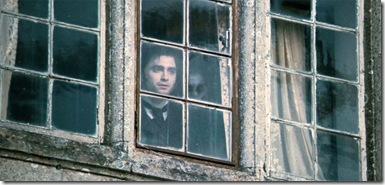The Woman In Black freaked out the audience at the screening I attended – this in spite of minimal blood and a decided lack of decapitations, amputations, eviscerations or any other form of torture porn.
Daniel Radcliffe’s first post-Harry movie is an old-fashioned haunted house/ghost story with all kinds of familiar, yet beautifully timed practical effects and, maybe, a teensy bit of CG sweetening.
Young widower Arthur Kipps [Radcliffe] gets sent off to the hamlet of Crythin Gifford to handle the paperwork of a recently deceased woman who lived in a spooky house on a promontory connected to the hamlet by a long causeway that is covered by the tide for long stretches. This assignment represents Kipps’ last chance to remain employed – since his wife died in childbirth, he hasn’t exactly set London ablaze with his work.
There are clichés in these kinds of movies – spooky old houses [check], inhospitable townspeople [check], a dog that barks at unseen threats [check], that frantically rocking empty rocking chair [check], creepy toys [check], and so on – but most of them still work when used judiciously and timed perfectly so, naturally, Kipps is told that he has no reservation at the inn [‘We’re booked solid for the week!’ glowers the innkeeper]; the town constable [David Burke, The Adventures of Sherlock Holmes] is less than helpful and only the very modern Mr. Daily [Ciarin Hinds], who drives a splendid new rolls Royce motorcar, seeming even the slightest bit friendly.
This third attempt by the new Hammer Films, in co-operation with CBS Films, to recapture the glory of the original Hammer might just get the job done [the first, Let Me In, was brilliant but did little business; the second, The Resident, went straight to VOD]. It works, not just because of the clichés – there’s even a raven for crying out loud!
Instead, The Woman In Black is effective because Jane Goldman [Stardust, Kick-Ass] has adapted the novel with an eye – and an ear – to salting those clichés into the story in such a way that they pop up at completely unexpected moments; a beat sooner here, a beat later there.
Also, Director James Watkins fills his cast with superb actors and lets them do what they do best, with combining music [Marco Beltrami’s score is genuinely eerie], practical effects and pacing to provide more than a few goosebumps moments. Goldman and Watkins also go for it in the end, too. From some perspectives, The woman In Black does not have a happy ending in the usual sense. From other, it’s a perfect, joyous conclusion to a dark, strange, genuinely chilling little movie.
Trust me, it was great to hear a young audience shrieking – and getting freaked out by a movie that didn’t really on eviscerations for its jump moments.
Final Grade: B+
